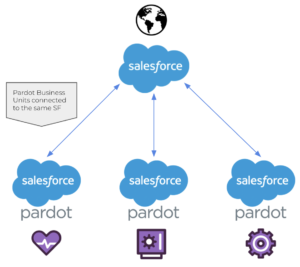This is the first blog in the Migrating to Pardot Business Units series. Let’s look at the first question you should ask yourself when considering a move to Business Units:
“Do you actually need Pardot Business Units?”
It’s a really exciting feature for Pardot and opens up a lot of potential for some businesses, particularly larger ones. However, this setup is not a magic wand that will transform your marketing automation strategy overnight.
Four signs that migrating to Business Units could be a great move for your business:
- You have multiple brand marketing teams or regional offices which operate largely independently. There are a few perfect use cases for Pardot Business Units. If your organisation has separate geographies, industry verticals or product & service lines, Business Units may be a great option for you.
- Your Salesforce Lead and Contact data is kept in separate segments for operational or compliance purposes. Some industries, such as financial services, have to keep customer data separate for legal reasons. Other organisations may keep data partitioned to avoid competition between brands under the same parent company. Whatever your reasons, if you have strict data visibility settings, Pardot Business Units could help structure your marketing data in the same way.
- Marketing campaigns or assets should not be shared or visible across all areas of the business. As well as separating your prospect data, you may also separate your marketing content across business lines. You can use Pardot Business Units to segregate campaigns which shouldn’t be shared with other teams.
- You already have multiple Pardot instances connected to one Salesforce instance. Before Business Units, some organisations operated out of multiple, separate Pardot instances to solve some of the problems listed above. If you have more than one Pardot account connected to the same Salesforce account, definitely start looking at Business Units!
A global business, running separate operations in the healthcare, financial services and manufacturing verticals might look like this:

However, if any of the following apply to your business, think carefully about the value that Business Units would be adding to your marketing automation platform.
Four signs that a migration might not be right for you:
- You have a large database and often carry out cross-brand or cross-functional marketing initiatives. Prospects count towards the database limit for all Business Units in which they have a mailable record – which means you pay for each unit they exist in. If you have a large database with a high degree of crossover between business functions, you could end up with a hefty bill.
- You regularly launch campaigns using the same assets across different regions, brands or business lines. Currently, sharing assets like Forms, Emails and Landing Pages across multiple Business Units is a manual process. Individually copying and recreating this in each account can be a huge time drain when launching a marketing campaign. The new Lightning Email and Landing Page builders and Snippets hold huge potential for simplifying this process, but for now other assets still require manual sharing.
- You are using Pardot (or Salesforce) Classic. Many of Pardot’s new features are only available through the Pardot Lightning app. If you’re still logging in via pi.pardot.com or using Salesforce Classic, you may need to migrate to Lightning before considering Pardot Business Units. This is a must if any users will need access to more than one Business Unit.
- There is no clear ownership of prospect data within your organisation. When setting up Business Units, you’ll need to tell Salesforce which of your prospects belongs where. This is usually based on record ownership, territory, brand alignment etc.. If your business does not have a clear way of determining ownership of prospects, separating them into different Business Units could be a huge headache.

By now, you should be feeling more confident about whether Pardot Business Units is right for your business’s marketing requirements. If you’re still unsure, or you’re ready to take the leap and start planning your migration, get in touch with our Business Units experts today.

